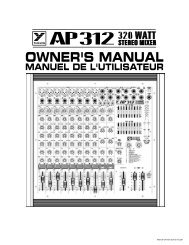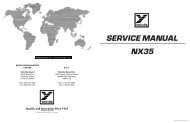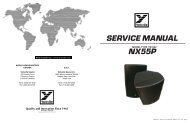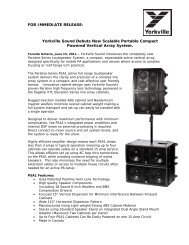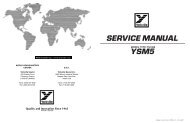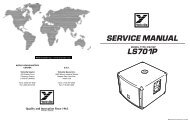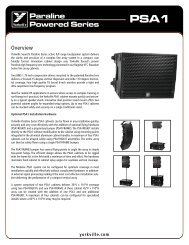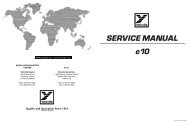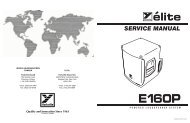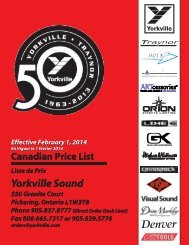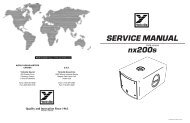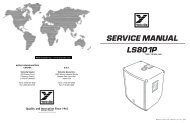owners manual / guide d' operation - Yorkville Sound
owners manual / guide d' operation - Yorkville Sound
owners manual / guide d' operation - Yorkville Sound
Create successful ePaper yourself
Turn your PDF publications into a flip-book with our unique Google optimized e-Paper software.
INTRODUCTION<br />
OWNERS MANUAL / GUIDE D' OPERATION<br />
Your new <strong>Yorkville</strong> Audiopro 3000 power amplifier is designed and built to provide<br />
years of trouble free performance. We believe it to be the best high power amplifier you<br />
can buy at any price.<br />
Up to now, owning a high power, high efficiency amplifier meant that you had to sacrifice<br />
sonic quality. With <strong>Yorkville</strong>’s 3000 design, we have overcome this problem. The 3000<br />
weighs a comfortable but solid 40 pounds, fits into two rack spaces, runs at near digital<br />
efficiency, reproduces music with over 4000 Watts of headroom, draws all the power<br />
it needs from a standard AC outlet, and has excellent distortion and noise specifications.<br />
It will drive reactive, phase shifted loads with no difficulty, and yet it is fully<br />
protected from accidental short circuits. Our design goal was to create an amplifier<br />
which would do exactly what an amplifier should do: reproduce music with great power,<br />
complete reliability, and complete signal fidelity. We think you will agree that the<br />
<strong>Yorkville</strong> 3000 does exactly that.<br />
We hope this <strong>manual</strong> will provide the answers to the questions you may have about the<br />
particular characteristics of this amplifier.<br />
Page 1
ENERGY<br />
MANAGEMENT<br />
SYSTEM<br />
INPUTS and<br />
SWITCHES<br />
MONO/STEREO<br />
OWNERS MANUAL / GUIDE D' OPERATION<br />
All amplifiers with ratings above 1400 watts rely on the fact that the average power<br />
required to reproduce music is considerably below the maximum power the amplifier<br />
is capable of providing. Some amplifiers are capable of actually delivering their rated<br />
power continuously, but these may consume as much as 50 amperes in doing so. To<br />
get around this problem, many high power amplifiers are shipped with either a special<br />
high current plug on the line cord or with two line cords. In practice, the user is often<br />
forced to find some way to connect these products to standard line outlets. Due to the<br />
lower average power required by music, this will sometimes work, but there is the<br />
possibility that circuit breakers in the concert hall will trip in the middle of a performance.<br />
The AUDIOPRO 3000 is internally capable of delivering its rated power on a continuous<br />
basis. However, rather than leaving the question of energy management to chance, the<br />
AUDIOPRO 3000 incorporates active energy management circuitry which continuously<br />
monitors the actual power consumed from the AC line. Should that exceed an average<br />
of 12 amperes over a sustained period, the AUDIOPRO 3000 will reduce its output<br />
power and therefore its power consumption accordingly. The reduction required is<br />
very small: A drop in output power of 3 dB will reduce the power consumption to below<br />
12 amperes in even the most extreme cases. Under prolonged actual tests with<br />
continuous and compressed music driving two ohm speaker loads connected to each<br />
channel, the AUDIOPRO 3000 consumed less than 10 amperes on average, and the<br />
energy management circuit was never activated. (This performance is due in large<br />
measure to the high efficiency of the AUDIOPRO 3000’s output circuitry: Other<br />
amplifiers draw considerably more power under identical conditions!) It is nice to know<br />
that an AUDIOPRO 3000 will probably never cause a nuisance trip of a breaker.<br />
The AUDIOPRO 3000 is a high efficiency amplifier which is capable of delivering a<br />
greater percentage of its input power to the speaker load than most other amplifiers.<br />
Under actual operating conditions its power conversion efficiency approaches that of<br />
digital switching amplifiers. However, digital switching amps are still plagued by poor<br />
specifications and cumbersome operating constraints. The AUDIOPRO 3000 provides<br />
the superior transient response and low distortion figures associated with the best and<br />
most reliable analog designs.<br />
The AUDIOPRO 3000 accepts either balanced or unbalanced inputs. Either XLR or<br />
PHONE cords may be used. XLR cords are normally used for balanced <strong>operation</strong>.<br />
However, stereo PHONE cords may also be used. Internally, the AUDIOPRO 3000<br />
inputs are simply wired in parallel: The TIP of the channel “A” PHONE input is<br />
connected to pin 2 of its XLR input, the RING is connected to pin 3, and the SLEEVE is<br />
connected to PIN 1.<br />
This switch simply connects the inputs of channel “A” directly to the inputs of channel<br />
“B”. A signal connected to either channel thus is routed to both amplifiers. Fig,#2- 2<br />
Page 2
DAISY CHAINING<br />
GROUND STRAP<br />
BRIDGED OPERATION<br />
OWNERS MANUAL / GUIDE D' OPERATION<br />
In large installations it is often necessary to operate many amplifiers in parallel. Several<br />
AUDIOPRO 3000 may be paralleled by patching from the unused input jack of the first<br />
amp to the second amp’s input, and so on down the line. The original source must drive<br />
all of the amplifiers. Eighteen AUDIOPRO 3000 channels would present a load of about<br />
600 Ohms. Any source capable of driving a 600 Ohm line to +15 dBm should be able<br />
to drive this load with no problem.<br />
For best results, daisy chaining should be done with balanced patch cords. Ground<br />
loop hum can be eliminated by lifting the ground straps of all but the first amplifier in the<br />
chain.<br />
Removing the ground strap on the rear panel will decouple chassis ground from circuit<br />
ground. Safety (“earth”) ground is still connected to the chassis. We do not<br />
recommend lifting the ground strap unless you are experiencing problems with ground<br />
loop hum in multiple amplifier setups where lifting the ground straps of all but one<br />
amplifier cures the hum problem. Caution: Sometimes hum problems are an indication<br />
of improper AC wiring somewhere else in your system. Don’t just doctor the symptom<br />
by lifting grounds: Fix the cause by making sure that the proper electrical wiring safety<br />
regulations have been adhered to.<br />
Historically, bridged mode <strong>operation</strong> was a means of getting high power from medium<br />
power amplifiers. The AUDIOPRO 3000 delivers more power from one channel than<br />
most other amps deliver when fully bridged. Bridging the AUDIOPRO 3000 will<br />
reproduce music with a headroom of about 4500 Watts into a 4 ohm load! We don’t<br />
know of any subwoofers that can handle such power. We recommend that you<br />
carefully check the ratings of your speaker system against the power specifications<br />
listed in this <strong>manual</strong> before you consider bridging the AUDIOPRO 3000.<br />
We have purposefully made it a little difficult to bridge the AUDIOPRO 3000. You need<br />
to construct a special crossed-phase balanced cable. If your input cable is a balanced<br />
XLR, you will need a stereo phone cable with the ring connection of one end going to<br />
the tip of the other end, and the ring of that end going to the tip of the first end. If your<br />
input cable is a phone plug, then you need to make an XLR patch cord with pin 2 of one<br />
end going to pin 3 of the other, and pin 3 of that end going to pin 2 of the first end. See<br />
Fig, #3. Connect the special cable from channel “A” to channel “B”. Connect the input<br />
to your AUDIOPRO 3000 to channel “A”. Put the STEREO/MONO switch in STEREO<br />
position. Connect your speaker between the two RED binding posts. (The resulting<br />
phase polarity is marked on the panel).<br />
You MUST set both front panel gain controls to the same position for bridged <strong>operation</strong><br />
to work properly. Failure to do this will result in premature current limiting and will<br />
produce less power than is produced in non bridged mode's.<br />
Again a word of CAUTION: <strong>Yorkville</strong>’s own high power speaker systems have circuit<br />
breaker protection built in. Although they may shut down, they are unlikely to be<br />
damaged by a bridged AUDIOPRO 3000. However, many other speaker manufacturers<br />
make high power cabinets with no protection features whatsoever. <strong>Yorkville</strong> <strong>Sound</strong><br />
Page 3
SUBSONIC FILTER<br />
PROTECT L.E.D.<br />
DC PROTECTION<br />
CLIP L.E.D.'S<br />
OTHER DESIGN<br />
DETAILS<br />
OWNERS MANUAL / GUIDE D' OPERATION<br />
LTD. is not responsible for any damage which may result as a consequence of<br />
exceeding such a speaker’s power handling capability. In any case, <strong>Yorkville</strong>’s two year<br />
unconditional warranty does not cover any consequential damages to other equipment.<br />
Please consider these facts carefully before you choose to run your AUDIOPRO<br />
3000 in bridged mode.<br />
The AUDIOPRO 3000 features a specially designed subsonic filter which effectively<br />
transfers the wasted energy from the band below 30 Hz to the band between 35 and<br />
70 Hz. The filter provides an 18 dB/Oct skirt below 40 Hz and a 3.6 dB boost at 50 Hz.<br />
This is achieved with a five pole network designed to minimize phase shift down to 40<br />
Hz. We recommend using this filter in conjunction with most subwoofers and with high<br />
power full range cabinets. Engaging this filter immediately produces the perception of<br />
a better “bottom end”, while excessive and possibly damaging excursions of the<br />
speaker cone are restrained. See Fig, #2- 1<br />
The PROTECT LED will glow steadily if the Energy Management System is activated.<br />
In the event of a shorted load or a load which is of too low an impedance for the amplifier<br />
to handle, (less than 2 ohms), the PROTECT LED will flash alternately on and off at<br />
about one second intervals. The sound may come on and off at the same rate. In this<br />
case, the fault in the speakers or the speaker cables should be located and remedied.<br />
No reset of the AUDIOPRO 3000 is required to restore proper <strong>operation</strong>.<br />
The AUDIOPRO 3000 is fully protected against all possible passive load conditions. It<br />
can operate with a “dead” short continuously without damage. The output stage uses<br />
a unique triple slope VI limiting scheme which is sophisticated enough to remain inert<br />
during transient currents in excess of 100 amperes and phase angles of more than 45<br />
degrees, yet is capable of protecting the output stage from damage due to accidental<br />
short circuits and improper loads. (You may have read that current limiting can affect<br />
the sound of an amplifier. Our answer to this is that it only gets in the way of the sound<br />
if it is not done properly. In the AUDIOPRO 3000, its done right!)<br />
In the unlikely event of the AUDIOPRO 3000 outputs “going DC”, a thyristor circuit will<br />
short the output and divert all potentially harmful currents away from your speakers.<br />
The CLIP LEDS on the front panel are of the pulse stretching type. Any excursion<br />
beyond the dynamic headroom of the amplifier - no matter how short - is trapped and<br />
converted into a visible pulse of light.<br />
The AUDIOPRO 3000 represents a significant advance in the art and science of analog<br />
power amplifier design. It incorporates MOSFETS where they should be used - in the<br />
driver stage where their immunity from secondary breakdown lets them reliably drive<br />
bi-polar output devices which can present an essentially capacitive load at high<br />
frequencies. The unique design of the output stage uses four supply voltages. This<br />
greatly reduces internal power dissipation. Rather than switching between the various<br />
supply voltages, the AUDIOPRO 3000 smoothly directs its output stage to the appropriate<br />
supply. The output is free of the “glitches” that plague other multiple supply<br />
Page 4
RELIABILITY<br />
APPLICATIONS<br />
OWNERS MANUAL / GUIDE D' OPERATION<br />
designs. In fact, due to the proprietary design of the power output section, the<br />
discontinuities visible on the distortion analysis product are much smaller than those<br />
normally associated with crossover distortion in single supply class AB designs. These<br />
circuit advances are clearly reflected in the superior specifications of the AUDIOPRO<br />
3000. The AUDIOPRO 3000 may be the first high power amplifier to offer specifications<br />
and sonic performance equal to or surpassing ultra low distortion designs such as<br />
class-A amplifiers.<br />
The AUDIOPRO 3000 is designed and manufactured by <strong>Yorkville</strong> <strong>Sound</strong> LTD. Each<br />
unit undergoes a thorough, temperature cycled burn-in period, and each circuit is<br />
tested by both <strong>manual</strong> and sophisticated computer controlled equipment which is<br />
capable of identifying any deviation from the design center parameters. The design of<br />
the AUDIOPRO 3000 is radical in concept but conservative with respect to the power<br />
handling capabilities of the output devices. The topology guarantees that thermal<br />
stress - not secondary breakdown - will set the limits of <strong>operation</strong>, while the computer<br />
optimized heat dissipation system insures that excessive thermal stress will not occur.<br />
<strong>Yorkville</strong>’s reputation as a manufacturer of reliable equipment will be further enhanced<br />
by the AUDIOPRO 3000.<br />
The AUDIOPRO 3000 was designed primarily for high power applications. It excels<br />
at driving big systems and subwoofers to their maximum SPL, and its rugged, roadworthy<br />
construction ensures that it will keep on doing just that - from location to location<br />
for years to come.<br />
The AUDIOPRO 3000 is not only suitable for use in both heavy duty touring sound<br />
reinforcement systems but also when high headroom and ultra-low distortion are<br />
needed to fully reproduce the dynamic range and clarity of today’s CD recordings. This<br />
last point needs emphasis: The AUDIOPRO 3000 will drive 8 Ohm loads with better<br />
sonic purity and lower distortion than any “listening amplifier” we know of, including<br />
those that cost much much more. And, since the AUDIOPRO 3000 is built to survive<br />
grueling road conditions and constant 2 ohm <strong>operation</strong>, its reliability in a fixed<br />
installation running 4 or 8 ohm studio monitors is without parallel.<br />
Of course, what really counts is how it sounds. Listeners have commented that the<br />
AUDIOPRO 3000 provides the clearest most transparent reproduction they have ever<br />
heard. You will have to judge for yourself.<br />
Page 5
SPECIFICATIONS<br />
OWNERS MANUAL / GUIDE D' OPERATION<br />
POWER:<br />
All values are in WATTS at 1KHz, except FTC 20Hz-20KHz.<br />
Measurements made with regulated 120 VAC sine wave at line cord.<br />
All values are rounded down to the nearest 25 watts.<br />
BURST AVG.<br />
Measured as a 2 cycle burst at 1KHz, 8:1 duty.<br />
(Continuous measurements may require line currents >15 Amps)<br />
ONE CHANNEL DRIVEN (WATTS)<br />
LOAD CONT, AVG,. BURST AVG PEAK INSTANT FTC 20-20KHz<br />
8 ohms 550 650 1500 475<br />
4 ohms 900 1250 3000 800<br />
2 ohms 1500 2250 6000 1200<br />
BOTH CHANNELS DRIVEN (WATTS)<br />
LOAD CONT, AVG,. BURST AVG PEAK INSTANT FTC 20-20KHz<br />
8 ohms 475 625 1500 425<br />
4 ohms 750 1200 3000 650<br />
2 ohms 1200 2175 6000 950<br />
BRIDGED (WATTS)<br />
LOAD CONT, AVG,. BURST AVG PEAK INSTANT FTC 20-20KHz<br />
16 ohms 925 1225 3000 850<br />
8 ohm 1500 2400 6000 1300<br />
4 ohms 2400 4350 12000 1900<br />
THD DISTORTION: ( measured at 1 dB below rated power, BW = 80 KHz )<br />
LOAD AT 1 KHz 20 Hz - 20 KHz<br />
8 ohms < 0.003 % < 0.04 %<br />
4 ohms < 0.004 % < 0.05 %<br />
2 ohms < 0.008 % < 0.06 %<br />
CROSS TALK: -75 dB below full power at 1KHz,<br />
-60 dB below full power, 20 Hz - 20 KHz.<br />
INPUT IMPEDANCE: 20K ohms balanced, 10 Kohms unbalanced.<br />
INPUT SENSITIVITY: 1.4 VRMS sine wave = full power. ( 36 dB gain )<br />
CMRR (bal input): >31 dB 20 Hz - 20 KHz<br />
CONTROLS: Rotary gain, MONO sw, special subsonic filter sw.<br />
DISPLAYS: 2x CLIP, 2x ACTIVITY, PROTECT, POWER ON. (LEDS)<br />
FREQUENCY RESPONSE<br />
Within 1dB, 20 Hz to 20 KHz, (50 Hz boost sw out)<br />
Page 6
OWNERS MANUAL / GUIDE D' OPERATION<br />
HUM AND NOISE: -105 dB below max output RMS voltage, unweighted.<br />
DC OFFSET: Less than 25 millivolts.<br />
PROTECTION: Fully protected: DC, LOAD and THERMAL.<br />
COOLING: Interleaved heatsink with DC servo controlled fan.<br />
SLEW RATE: Power amp: 30 V/usec, 60 V/usec in bridged mode.<br />
(rise time limited to 18 V/usec by input filter).<br />
DAMPING FACTOR: > 500, 20 Hz - 400 Hz, into 8 ohms.<br />
MAX OUTPUT CURRENT:<br />
` 100 amperes for 10 milliseconds, 50 amperes contin.<br />
TURN ON/OFF: < 15 milliwatt / seconds, 0.5 Wpk. (1s on delay)<br />
EFFICIENCY: Better than 75% at full power into 4 Ohms.<br />
WEIGHT: 40 pounds. 17.75 Kilograms.<br />
SIZE: 3.5" x 19" x 15.75 (front panel to binding posts)<br />
POWER SUPPLY: Toroidal transformer, 82,000 uF filter caps, combination<br />
power switch/circuit breaker.<br />
POWER CONSUMPTION:<br />
Will not exceed 13.5 Amps under actual conditions.<br />
Page 7
TROUBLE<br />
SHOOTING<br />
GUIDE<br />
OWNERS MANUAL / GUIDE D' OPERATION<br />
SYMPTOM POSSIBLE CAUSE PROBABLE SOLUTION<br />
Power/breaker switch is on,<br />
but power LED is off<br />
No music through speakers<br />
The music at channel ‘A’s input<br />
is heard on channel ‘B’s<br />
output or vise versa.<br />
Protect LED flashes on and off<br />
Protect LED is continuously<br />
on. Fan is on high speed.<br />
Protect LED is continuously<br />
on. Fan is on high speed.<br />
There’s no sound on the outputs.<br />
No AC power<br />
No music at amplifier’s input.<br />
Volume controls turned down.<br />
Damaged speaker. Faulty<br />
speaker cable.<br />
The amplifier is in mono mode.<br />
If music is present at the amplifier’s<br />
inputs and the activity<br />
LEDS flash in step with the<br />
protect led, a short or load<br />
less than 2 ohms is present on<br />
the corresponding output.<br />
The Energy Management System<br />
is correcting for excessive<br />
current draw through the<br />
AC line cord.<br />
The amplifier has overheated.<br />
Connect AC power cord to a<br />
live AC receptacle<br />
CAUTION: Do not remove<br />
chassis cover as there are no<br />
replaceable fuses contained<br />
inside<br />
To verify that the music is getting<br />
through the amplifier: connect<br />
music to the amplifier’s<br />
inputs, turn the volume controls<br />
up, verify that activity<br />
LEDS are flickering.<br />
Check speakers, and cables.<br />
Put mono/stereo switch in<br />
stereo position (out)<br />
If multiple speaker cabinets<br />
are connected to the amplifier’s<br />
output, disconnect them<br />
one by one until the protect<br />
LED turns off. If the problem<br />
persists with no signal on the<br />
input and no speakers are<br />
connected, have the amplifier<br />
serviced by authorized personal.<br />
The amplifier is automatically<br />
turning down the music so that<br />
the circuit breaker does not<br />
trip. No action needs to be<br />
taken. This is a rare but normal<br />
condition.<br />
Remove any obstruction from<br />
the ventilation holes. Amplifier<br />
will reset after cooling.<br />
Page 8
INTRODUCTION<br />
OWNERS MANUAL / GUIDE D' OPERATION<br />
Votre nouvel amplificateur de puissance AUDIOPRO AP-3000 a été conçu et fabriqué<br />
pour vous servir avec fiabilité pour bien des années a venir. Nous croyons que le AP-<br />
3000 est le meilleur amplificateur de puissance que vous pouvez acheter à n’importe<br />
quel prix.<br />
Jusqu’à maintenant, on devait sacrifier la qualité sonore pour posséder un amplificateur<br />
de haute puissance parce que ce type d’amplificateur a normalement un plus haut taux<br />
de distortion qu’un amplificateur de puissance moins élevée. Nous avons résolus ce<br />
problème avec la conception du AP-3000 de <strong>Yorkville</strong>. Le AP-3000 a un poids<br />
confortable, mais solide de 35 livres, s’installe dans 2 “espaces rack”, fonctionne avec<br />
une efficacité que se rapproche des conception numérique, reproduit la musique avec<br />
au-delà de 4000 watts d’extention dynamique, tire toute la puissance requise d’une<br />
prise CA standard et possède d’excellentes spécifications pour le bruit et la distortion.<br />
Il peut conduire une charge réactive et déphasée sans difficulté, toute en restant<br />
pleinement protegé contre les court-circuits accidentels. Notre bût était de conçevoir<br />
un amplificateur qui ferait exactement ce qu’un amplificateur devrait faire: reproduire<br />
la musique avec puissance et fidelité tout en étant extrêmement fiable. Nous sommes<br />
confiant que vous serez d’accord que c’est exactement ce que le AP-3000 fait.<br />
Nous espérons que ce manuel répondera aux questions que vous pourriez avoir à<br />
propos des caractéristiques particulières du AP-3000.<br />
Page 9
SYSTEME DE<br />
GESTION<br />
ENERGETIQUE<br />
ENTREES ET<br />
COMMUTATEURS<br />
OWNERS MANUAL / GUIDE D' OPERATION<br />
La discussion qui suit implique une opération avec 120 VCA 60 Hz.<br />
Tous les amplificateurs qui ont une puissance nominale au-dessus de 1400 watts<br />
comptent sur le fait que la puissance moyenne requise pour reproduire la musique est<br />
considérablement en-dessous de la puissance maximum que l’amplificateur est<br />
capable de fournir. Quelques-uns de ces amplificateurs peuvent vraiment, de façon<br />
continue, fournir leur puissance nominale, mais en opérant ainsi, ils peuvent consommer<br />
jusqu’a 50 ampères. Pour contourner ce problème, plusieurs amplificateurs sont<br />
expédiés avec soit une prise spéciale pour courant élevé sur le cordon d’alimentation,<br />
soit deux cordons d’alimentation. En pratique, l’utilisateur est souvent forcé de trouver<br />
une façon de brancher ces appareils à une prise de courant standard. Parce que la<br />
musique requiert normalement une puissance moyenne moins élevée, cela peut<br />
parfois fonctionner, mais il y a alors une possibilité que le circuit disjoncteur de la salle<br />
de concert déclanche.<br />
Le AP-3000 est internalement capable de fournir sa puissance nominale sur une base<br />
continue. Toutefois, au lieu de laisser la question de gestion énergétique au hazard, le<br />
AP-3000 possède un circuit actif de gestion énergétique qui vérifie constament la<br />
consommation de puissance à partir du cordon d’alimentation CA. Si cette consommation<br />
excède douze ampères sur une période de temps soutenue, le AP-3000 réduit<br />
automatiquement sa puissance de sortie pour ainsi réduire sa consommation de<br />
puissance. La réduction requise est très petite: une chutte de 3 dB à la sortie va réduire<br />
la consommation de puissance en-dessous de 12 ampères même dans les cas<br />
extrêmes. Sous des tests prolongés, avec de la musique continue et compressée et<br />
un haut-parleur de 2 ohm branché a chaque sorties, le AP-3000 a consommé en<br />
moyenne moin de 10 ampères et le systeme de gestion énergétique n’a jamais été<br />
déclanché. On attribue cette performance en grande partie a la haute éfficacité du<br />
circuit de sortie du AP-3000: Dans les même conditions, les autres amplificateurs<br />
consomme beaucoup plus de puissance. Il est rassurant de savoir que le AP-3000 ne<br />
déclanchera probablement jamais un disjoncteur de courant.<br />
La haute éfficacité du AP-3000 lui permet de livrer a sa sortie un plus haut pourcentage<br />
de la puissance présente a l’entrée que la pluspart des amplificateurs. Sous des<br />
conditions d’opération réelles, son éfficacité a convertir la puissance se rapproche de<br />
celle des amplificateur a commutateur numérique. Toutefois, les amplificateurs à<br />
commutateur numérique demeurent tourmentés par des spécifications médiocres et<br />
une opération restrainte encombrante. Le AP-3000 fournit une meilleur réponse des<br />
transitoires et des figures de distortion basse associées avec les meilleurs et les plus<br />
robuste amplificateur analogue.<br />
Le AP-3000 accepte des entrées symétrique et assymétrique. Les prises 1/4" ou XLR<br />
peuvent êtres utilisé. Les fils avec prise XLR sont normalement utilisés pour une<br />
opération symétrique, toutefois les prise 1/4" stéréo peuvent aussi être utilisées. Les<br />
entrées du AP-3000 sont internallement branchées en parallèle: la pointe de la prise<br />
d’entrée 1/4 du canal A est branché a la tige 2 de la prise XLR correspondante.La<br />
couronne est branché at la tige 3, et le manchon a la tige 1.<br />
Page 10
MONO / STEREO<br />
MONATGE EN CHAINE<br />
TRESSE DE MISE<br />
A LA TERRE<br />
OPERATION EN PONT<br />
OWNERS MANUAL / GUIDE D' OPERATION<br />
Ce commutateur raccorde simplement l’entrée du canal “A” a l’entrée du canal “B”. Le<br />
signale branché a l’un ou l’autre des entrées s’achemine donc vers les 2 amplificateurs.<br />
Pour de larges opérations, il est souvent nécessaire d’utiliser plusieurs amplificateurs<br />
en parallèle. Plusieurs AP-3000 peuvent êtres raccordés en parallèle à partir des prises<br />
d’entrée.Brancher simplement la prise d’entrée qui n’est pas utilisée du premier AP-<br />
3000 à la prise d’entrée du second et ainsi de suite. La source originale doit entrainer<br />
tous les autres. Dix-huit AP-3000 représente une charge d’environ 600 ohms. N’importe<br />
quelle source capable de livrer + 15 dB a 600 ohms devrait être capable de piloter cette<br />
charge sans problème.<br />
Pour de meilleur résultat lors des montage en chaine, utilisez des fils symétriques. On<br />
peut éliminer le bourdonnement associé au boucle de masse en déconnectant les<br />
tresses de mise à la terre sur tous les amplificateurs excepté le premier.<br />
Débrancher la tresse de mise a la terre sur le panneau arriere de AP-3000 découple la<br />
masse entre le châssis et le circuit. La mise à la terre de sûreté demeure toutefois<br />
branche au châssis. A moins que vous n’ayez des problemes de bourdonnement due<br />
a la boucle de masse nous vous recommandons de laisser la tresse de mise a la terre<br />
branchée. ATTENTION: Les problèmes de bourdonnement indiquent parfois un<br />
mauvais câblage AC dans votre système. Ne réglé pas ces problèmes en levant<br />
simplement les tresses de mises à la terre: assurez-vous que votre câblage électrique<br />
est en accord avec les normes de sécurité.<br />
Historiquement, opérer un amplificateur en pont était un moyen d’obtenir plus de<br />
puissance à partir d’un amplificateur de puissance moyenne. Le AP-3000 livre plus<br />
de puissance sur un canal que la pluspart des amplificateurs montés en pont. Avec un<br />
charge de 4 ohms, en pont, le AP-3000 peut reproduire la musique avec une extention<br />
dynamique de 4500 watts! A notre connaissance, aucun haut-parleur de basse ne peut<br />
soutenir autant de puissance, nous vous recommandons donc de verifier la puissance<br />
nominal de vos haut-parleur et de la comparer avec les specifications incluses dans ce<br />
manuel.<br />
Nous avons consciencieusement rendue le raccordement en pont du AP-3000 difficile.<br />
Vous devez fabriqué un fil équilibré à phase croisée spéciale. Si vous utilisez un fil XLR<br />
symétrique à l’entrée, vous avez besoin d’un fil stéréo avec fiche 1/4" stéréo configuré<br />
comme ceci: l’anneau a un bout du fil, doit être branchée à la pointe de l’autre bout et<br />
la pointe à l’anneau. Si vous utilisé à l’entrée un fil avec prise 1/4" , vous aurez besoin<br />
d’un fil XLR configuré comme ceci: la tige 2 à un bout du fil doit être branchée à la tige<br />
3 à l’autre bout et la tige 3 à la tige 2. Brancher ce fil spéciale du canal “A”au canal “B”<br />
de votre AP-3000, et injecté le signal d’entré au canal “A”. Placé le commtateur<br />
STEREO/MONO à la position ‘STEREO’ et brancher votre haut-partleur au 2 bornes de<br />
raccordement rouges. (La polarité de phase qui en résulte est inscrite sur le panneau.)<br />
Page 11
FILTRE SUBSONIQUE<br />
D.E.L PROTECRICE<br />
OWNERS MANUAL / GUIDE D' OPERATION<br />
Pour que l'opération en pont fonctionne correctement, vous devez régler les deux<br />
contrôles de gain à la même position, faute de quoi, le courant sera limité prémateurément<br />
et la puissance de sortie sera moins grande qui si l'amplificateur était utilisé en mode<br />
régulier.<br />
ATTENTION: Un disjoncteur de protection est encastré dans les systemes de hautparleurs<br />
haute puissance de <strong>Yorkville</strong>. Quoiqu’ils peuvent cessé temporairement de<br />
fonctionner, il est peu probable qu’ils soient endommager par un AP-3000 opéré en<br />
pont. Toutefois, plusieur fabriquants produisent des cabinets haute puissance sans<br />
protection. <strong>Yorkville</strong> <strong>Sound</strong> Ltd n’est responsable d’aucun dommage qui pourrait être<br />
cause par un excès de puissance appliqué sur des haut-parleurs incapable de la<br />
soutenir. La garantie inconditionnelle de 2 ans de <strong>Yorkville</strong> ne couvre en aucun cas, les<br />
dommages conséquent sur les autres équipments. Veuillez S.V.P. considerer<br />
attentivement ces fait avant de considerer utiliser votre AP-3000 en mode “montage en<br />
pont”.<br />
Le AP-3000 se distingue avec un filtre subsonique spécialement conçue qui transfert<br />
efficacement l’énergie perdue des bandes inférieur a 30 Hz au bandes entre 35 et 70<br />
Hz. Le filtre prévoit une coupure de 18 dB/Oct en-dessous de 40Hz et un renforcement<br />
de 3.6 dB à 50 Hz. Tout ceci est réalisé grâce à un réseau à 5 pôles conçue pour<br />
minimisé le déphasage en-dessous de 40 Hz. Nous vous recommandons d’utiliser ce<br />
filtre en conjonction avec la pluspart des haut-parleurs de grave ainsi qu’avec les<br />
cabinets pleine bande de haute puissance. Une meilleur perception des basses<br />
fréquences et un protection contre les excursions excessives qui pourrait possiblement<br />
endommager les haut-parleurs sont les résultats obtenues suite à l’engagement de ce<br />
filtre subsonique.<br />
Lorsque le systeme de gestion énergétique est actif, la D.E.L. protectrice reste<br />
constamment illuminée. Lorsqu’une charge court-circuitée ou une charge dont<br />
l’impédance est inférieur à ce que l’amplificateur peut supporter (moins de 2 ohms) se<br />
presente a celui-ci, la D.E.L. protectrice clignote à des intervalles d’environ une<br />
seconde. Le son peut être coupé et activé à la même fréquence. Dans ce cas, on doit<br />
localiser et réglé le problème qui réside dans les haut-parleurs ou dans le câblage des<br />
haut-parleur. Aucun réglage du AP-3000 n’est nécessaire pour restorer le mode<br />
d’opération.<br />
Le AP-3000 est pleinement protégé contre les charges passive. Il peut opérer sans<br />
cause de dommage, une charge court-circuitée continue. L’étage de sortie utilise un<br />
arrangement limiteur a triple pentes d’attenuation suffisament sophistiqué pour demeurer<br />
neutre durant les transitoires de courant qui excède 100 ampères et les angles<br />
de phase de plus de 45° tout en protégeant l’étage de sortie contre les dommages<br />
causé par des charges court-circuitées ou des charges trop basses accidentelles.<br />
(Vous avez possiblement lu que limiter le courant pourait affecter la qualité sonore d’un<br />
amplificateur. Notre réponse à ceci est que cela peut être un obstacle seulement si l’on<br />
en fait un usage incorrecte. Le AP-3000 en fait un usage impécable.)<br />
Page 12
AUTRES DETALIS<br />
DE CONCEPTION<br />
FIABLITE<br />
APPLICATIONS<br />
OWNERS MANUAL / GUIDE D' OPERATION<br />
Les D.E.L. indicatrices d’écrêtage sur le panneau avant sont du type correcteur de<br />
forme. N’imorte quelle excursion, aussi petite qu’elle soit, qui dépasse les limites de<br />
l’extention dynamique de l’amplificateur, est piégée et convertit en un clignotement<br />
lumineux.<br />
Le AP-3000 représente un avancement considérable dans l’art et la science de la<br />
conception de l’amplificateur analogue. Les transistors à effet de champ sont incorporés<br />
à l’étage pilote où leur immunité contre les claquement secondaire leur permet<br />
d’entrainer, avec fiabilité, les pièces de sortie bipolaires qui peuvent présenter à haute<br />
fréquence, une charge essentiellement capacitive. La conception unique de l’étage de<br />
sortie utilise quatre tensions de réseau, ce qui réduit considérablement la dissipation<br />
de puissance interne. Plutôt que d’utiliser la commutation entre plusieurs tension de<br />
réseau, le AP-3000 dirige sont étage de sortie sur le réseau approprié, ce qui libère la<br />
sortie des transitoires qui tourmente les autres conception à multiple alimentations. En<br />
fait, due au proprietés de la conception de la section de sortie, les discontinuitées<br />
visibles sur l’analyse de distortion sont considérablement plus petites que ceux<br />
normallement associés avec la distortion de croisement dans un amplificateur de<br />
classe AB à alimentation simple. Les spécifications supérieures du AUDIOPRO 3000<br />
reflète clairement la perfection de ses circuits. Le AP-3000 est probablement le premier<br />
amplificateur haute puissance à offir des spécifications et une performance audio<br />
équivalente où supérieur à celles des amplificateurs à distortion très basse telle que<br />
les amplificateurs “classe A”.<br />
Le AUDIOPRO 3000 a été conçu et fabriqué par <strong>Yorkville</strong> <strong>Sound</strong> Ltd. Chaque appareil<br />
subit une période de rodage minutieuse et chaque circuit est testé manuellement ainsi<br />
qu’avec équipment controllé par ordinateur. L’AUDIOPRO 3000 représente un changement<br />
de concept radical mais demeure toutefois conservateur par rapport à sa<br />
puissance nominale. L’étude des propriétés garantie que la contrainte thermique, et<br />
non les claquements sécondaire, déterminera la limite d’opération alors que le<br />
système de dissipation de chaleur assure la limitation des contraintes thermiques. La<br />
réputation de fabriquant d’appareil fiable de <strong>Yorkville</strong> ne peut être qu’accrue avec le AP-<br />
3000.<br />
Le AUDIOPRO 3000 a été conçu pour les opérations où une haute puissance est<br />
requise. Il est excellent pour obtenir des systèmes importants et des haut-parleurs de<br />
grave une pression sonore maximum et sa construction robuste vous assure une<br />
fiabilité à toute épreuve pour bien des années à venir.<br />
Le AUDIOPRO 3000 est non seulement excellent pour les situations qui demandent un<br />
grand rendement, mais il excelle aussi à reproduire la clarté des enregistrements sur<br />
disque compact où une extention dynamique considérable et un très bas taux de<br />
distortion sont nécessaires. Le AUDIOPRO 3000 peut conduire une charge de 8 ohms<br />
avec une meilleur qualité sonore et un taux de distortion plus bas que n’importe quel<br />
amplificateur d’écoute que nous connaissons. Considérant le fait que le AP-3000 peut<br />
Page 13



